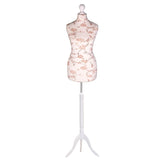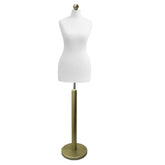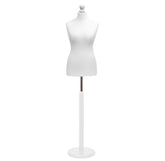Choosing an Adjustable Dummy Dressmaker
Think of an adjustable dressmaker's dummy as your silent partner in the sewing room. It’s essentially a customisable body double, standing in so you can get the fit of your garments just right. This is the tool that takes a flat, two-dimensional pattern and helps you turn it into a three-dimensional piece of clothing, allowing you to drape, pin, and tweak the fabric with real precision. It’s the secret to closing the gap between a paper pattern and a real person's body.
Your Essential Partner in Garment Creation

Could you imagine trying to sculpt without an armature to build upon, or painting a portrait without a model sitting for you? It's not impossible, of course, but the whole process would be riddled with guesswork and frustration. For anyone serious about sewing, an adjustable dressmaker’s dummy plays that same crucial role; it provides the fundamental structure you need to bring your creative vision to life, accurately and confidently.
This single tool lifts your work off the flat cutting table and into the real world. You can finally see how a fabric actually behaves in three dimensions—how it hangs, where it needs a bit of shaping, and how it drapes over curves. Getting this right is what separates a homemade look from a professional finish, and it can save you countless hours of tedious fitting sessions and alterations down the line.
Bridging the Gap Between 2D Patterns and 3D Forms
A paper pattern can only ever tell part of the story. The real test comes when that flat design has to wrap around the curves of a human body. This is where an adjustable form becomes your stand-in, letting you test, refine, and perfect your work in a completely realistic way.
It becomes a silent collaborator, helping you achieve:
- An Impeccable Fit: By dialling in the dummy to precise measurements, you can make sure every single seam, dart, and pleat falls exactly where it’s meant to.
- Creative Freedom: It opens the door to more advanced techniques like draping, which is almost impossible to get right on a flat surface.
- Better Use of Your Time: You can spot and fix fitting problems right at the start, which dramatically cuts down on rework and unpicking later on.
An adjustable dressmaker's dummy isn't just another piece of equipment; it's a cornerstone of a well-organised creative space. It helps you work smarter by visualising the final garment and making critical adjustments long before you sew the final stitches.
These forms have a rich history that’s tied directly to the story of British garment making. From the Industrial Revolution forward, legendary tailoring communities like those on Savile Row needed tools that could handle precise adjustments for both bespoke and ready-to-wear clothing. The adjustable dummy was a massive leap forward, moving the craft from simple flat pattern cutting to true three-dimensional construction.
More Than Just a Mannequin
At the end of the day, an adjustable dummy dressmaker is so much more than a static display mannequin. It's an active, hands-on participant in your design process. Think of it as a customisable canvas you can pin into, drape over, and sculpt fabric onto. For any serious sewer, it’s an essential piece of kit that provides the support needed to turn ambitious ideas into beautifully fitted realities.
Of course, having the right tools is only half the battle; it all starts with a well-planned workspace. For more ideas on putting together an effective area, have a look at our complete guide to your sewing room setup.
Comparing Different Types of Dressmaker Dummies
Picking the right adjustable dressmaker dummy is a bit like an artist choosing the perfect brush—the right one makes all the difference, giving you the precision and confidence to bring your vision to life. Not all dress forms are created equal, and knowing what sets them apart is the key to finding your ideal creative partner.
While the options might seem overwhelming at first, they generally fall into three main camps: dial-adjustable dummies, foam-backed pinnable forms, and professional-grade models. Each type has its own personality and purpose, designed for different sewing styles and projects. Let's dive into what makes each one tick.
Dial-Adjustable Dummies: The Flexible All-Rounders
For many sewers, the dial-adjustable dummy is their first foray into the world of dress forms. Their biggest selling point? Sheer versatility. These models are typically built with a hard plastic inner shell wrapped in a thin fabric layer. They feature a series of dials or keys—usually between 8 to 12 adjustment points—that let you expand or contract the bust, waist, and hip sections.
Think of it as a clever mechanical puzzle. With a few turns of the dials, you can shift the dummy's circumferences to match a whole range of body measurements. This makes them a brilliant choice for dressmakers working with different clients or for anyone whose own measurements tend to fluctuate. They offer a quick, straightforward way to get a good approximation of various body shapes without needing a room full of dummies.
Of course, this flexibility comes with a small trade-off. As you expand the sections, gaps can appear between the panels. This isn't a problem for general fitting, but it can make precision draping a bit tricky. The thin fabric cover also isn't always fully pinnable, meaning you often have to insert pins at an angle instead of straight in.
Key Takeaway: Dial-adjustable models are fantastic for general fitting and alterations across various sizes. They offer maximum flexibility but might not have the solid, seamless surface needed for professional-level draping.
The image below gives you a sense of the key specifications to look for when comparing different adjustable dressmaker dummies.

As you can see, the adjustment range and capacity can vary hugely between models, and these are crucial details to consider when making your choice.
Foam-Backed Pinnable Forms: The Drape Artist's Choice
Foam-backed or "pinnable" forms offer a totally different feel. Unlike their dial-operated cousins, these dummies have a solid torso, usually made from polystyrene or another dense foam. This is a game-changer because it means you can push pins straight into the body from any angle—a dream for anyone who loves draping fabric or creating patterns directly on the form.
These models give you a smooth, uninterrupted surface that’s much closer to a real human torso, completely avoiding the gaps you get with dial-based dummies. While many are fixed-size, you can find adjustable versions, although they tend to have fewer adjustment points. Their stability and seamless surface make them a firm favourite among fashion students and designers.
The main thing to remember here is that a single form won't cover a massive range of sizes. You'll need to choose one that's already close to your target measurements and then use padding to get that perfectly customised fit. A sturdy base is also non-negotiable; you can learn more about what makes a great dress form stand to keep your work steady and secure.
Professional-Grade Dummies: The Industry Standard
Finally, we arrive at the professional-grade dummies—the kind you'll find in a top design studio or a prestigious fashion house. These are the gold standard, often built from heavy-duty materials like fibreglass with a classic linen cover. They're engineered for durability and are calibrated with absolute precision to standard industry sizes.
Professional forms often come with clever features like collapsible shoulders, which make it much easier to slip tight-fitting garments on and off without stretching them. They also tend to have more detailed, realistic shapes, including defined shoulder blades and a true-to-life posture, which are vital for high-end tailoring.
These dummies are a serious investment and are almost always fixed-size. They aren't "adjustable" in the turn-of-a-dial sense. Instead, they provide an unwavering, accurate foundation for designers creating entire collections based on standard sizing. They’re less suited for a home sewer who needs to replicate one specific, non-standard body shape.
Comparison of Adjustable Dressmaker Dummy Types
To help you visualise the differences, this table breaks down the key features of each dummy type. Think of it as a quick-reference guide to match the right form to your sewing needs.
| Dummy Type | Adjustment Mechanism | Best For | Key Advantage | Potential Drawback |
|---|---|---|---|---|
| Dial-Adjustable | 8-12 dials/keys that expand or contract internal panels. | Home sewers, dressmakers with varied clients, general fitting. | High versatility across a wide range of sizes. | Gaps can form between panels; not fully pinnable. |
| Foam-Backed Pinnable | Solid foam body; some versions have limited adjustment points. | Draping, pattern making, designers, fashion students. | Solid, seamless, and fully pinnable surface. | Limited size range per form; requires padding for custom fits. |
| Professional-Grade | Typically fixed-size, calibrated to industry standards. | Professional designers, high-end tailoring, fashion houses. | Extreme durability, precision, and realistic anatomical shape. | High cost and not adjustable for non-standard body types. |
Ultimately, the best dummy is the one that aligns with your projects. Whether you need the quick-change adaptability of a dial-adjustable model or the unwavering precision of a professional form, understanding these core differences is the first step toward making a confident choice.
Selecting the Right Size and Material

Choosing your first adjustable dummy dressmaker is a bit like laying the foundations for a house; get the base right, and everything you build on top will be solid. Getting the size and material spot-on from the outset is the secret to achieving a perfect fit in your garments. It’s a decision that will influence every single piece you drape, pin, and perfect.
The process doesn't start with browsing dummies, though. It starts with you. Grab a flexible tape measure and jot down your own core dimensions—specifically your bust, waist, and hips. This is your personal blueprint.
Matching Your Measurements to a Dummy
With your measurements in hand, you can start comparing them to the adjustment ranges of various models. Every adjustable dummy has a minimum and a maximum for its key circumferences. Your goal is to find a model where your own measurements sit comfortably somewhere in the middle of that range, not pushed to either extreme.
Now, here’s a golden rule that seasoned dressmakers live by, and it might seem a bit backwards at first.
Always choose a dummy that is slightly smaller than your own body measurements. You can always add padding to build up the form, but you can never make a dummy smaller than its minimum setting.
This is the key to creating a true body double. Starting with a smaller base gives you the creative freedom to add wadding or foam pads, letting you perfectly replicate your unique curves, posture, and any little asymmetries we all have. Trying to work on a form that’s even slightly larger than you is a recipe for frustration and clothes that just won't sit right.
If you want to dive deeper into getting this right, you can learn more about taking and applying mannequin measurements in our detailed guide.
Understanding Dummy Materials and Construction
Beyond the all-important size, the materials and build of the dummy have a huge impact on its usability and how long it will last. You're mainly looking at two components: the torso and the stand.
Torso Materials
The body of the dressmaker's dummy is where the magic happens, and its material dictates how you can work with it.
- Plastic Body with Fabric Cover: Most dial-adjustable dummies are built around a hard plastic shell. This is then covered in a thin, foam-backed fabric, usually nylon. They're lightweight and budget-friendly, but pinning can be tricky. You often have to slide pins in at an angle, aiming for the gaps between the panels.
- Solid Foam Body: A fully pinnable dummy is a different beast altogether. Usually made from a dense polystyrene or similar foam, it allows you to push pins straight into the body from any angle. This is a massive advantage for draping and pattern making, giving you a firm, seamless surface that feels much closer to a real torso.
Stand and Base Options
A wobbly dummy is a dressmaker's nightmare, so stability is non-negotiable. The base needs to be sturdy enough to handle the weight of heavy fabrics like denim or wool without a single wobble.
- Tripod Stands: The classic choice for a reason. These three-legged stands, often made of wood or metal, provide excellent stability. A wooden stand, like the one you'd find on a Lady Valet model, can also add a lovely, elegant touch to your sewing space.
- Four-Legged or Pedestal Stands: Also a very common and practical option. Metal four-legged stands are often lightweight and can be folded away for easy storage, which is a real bonus in smaller rooms. For maximum stability, a heavy pedestal base is unbeatable, though it's not as easy to move around.
Ultimately, picking the right size and material is a balance between your body shape, your sewing goals, and your budget. By measuring yourself carefully, choosing a slightly smaller form, and thinking about how you’ll use it, you'll invest in a reliable partner that will serve you well for years to come.
Mastering Adjustments for a Perfect Fit
Unpacking your new adjustable dummy is one thing, but the real magic begins when you start shaping it. Think of it less like putting together furniture and more like sculpting. You're about to turn a standard form into a precise double of a real person—whether that's you or a client. It's this body double that will become the secret to creating garments that fit like a dream.
The whole process really breaks down into two main stages. First, you'll get the basic framework right using the mechanical dials and sliders. Then comes the artistry: padding out the form to add those subtle, unique curves that make a body, well, a body.
Setting the Core Measurements with Dials
The dials on your dummy are your starting point—they set the foundational bust, waist, and hip measurements. But before you even think about turning a dial, you need a solid set of body measurements. If you're not confident in this, our guide on how to take body measurements for clothes walks you through it step-by-step.
With your numbers in hand, it's best to work methodically to keep the dummy balanced:
- Start from the Top: If your model has a neck adjustment, begin there.
- Adjust the Bust: Slowly turn the bust dials. The key is to make small, even adjustments, alternating between the front and back dials to expand the form symmetrically.
- Define the Waist: Next, move down to the waist. Again, small and gradual turns are the way to go to avoid distorting the shape.
- Set the Hips: Finally, tackle the hip dials. Just like with the bust, work on the front, back, and sides together to maintain a natural, balanced silhouette.
- Check Torso Length: Many dummies also have a back-waist length adjustment. Set this to match the measurement from the base of the neck down to the natural waist.
Take your time with this. After every few turns, grab a tape measure and check your progress. You’re aiming to get the main circumferences just a fraction smaller than your target measurements. This leaves you the perfect amount of room for the next, and arguably most crucial, stage.
The secret to a perfect fit isn't just in the dials; it's in the padding. The dials create the blueprint, but padding adds the personality and unique contours of a real human body, turning a generic form into your personal body double.
The Art of Sculpting with Padding
This is where your dummy truly comes to life. Don't worry about the gaps that appear between the panels when you expand the dials—they’re not a design flaw, they’re an opportunity. Using polyester wadding (batting) or even some sculpted foam pads, you can now add all the specific contours that make a physique unique.
Think about building up areas layer by layer. You might be:
- Adding a bit more fullness to the bust.
- Creating a softer, more rounded tummy below the waist.
- Building out the hips and thighs for a classic pear shape.
- Padding the upper back to account for a slight stoop or rounded shoulders.
The goal is to create a firm but smooth surface. Once you've got the padding in place, a brilliant finishing touch is to make a custom-fitted cover for your dummy out of something like jersey or spandex. This cover does two things: it compresses the wadding to smooth out any little lumps and, best of all, it completely hides the gaps between the panels. You're left with a seamless, pinnable surface that is a perfect replica of the body you're sewing for.
By getting comfortable with both the mechanical settings and the more creative padding process, your adjustable dummy dressmaker stops being just a tool. It becomes a genuine partner in your sewing, helping you ensure every single garment you make is destined to fit beautifully.
Using Your Dummy for Creative Projects

Once you've dialled in those measurements, your adjustable dummy stops being just a piece of equipment and becomes your most trusted creative partner. This is the moment you can step away from the limitations of flat paper patterns and start sculpting with fabric in three dimensions. It’s where your garment-making skills can truly come alive.
Think of it as your silent assistant. It’ll patiently hold your fabric as you figure out a tricky neckline, let you check the hang of a tailored jacket, and provide the perfect, stable form for marking a dead-straight hem. For fit, form, and silhouette, it's your constant point of reference.
Draping and Pattern Design
One of the most exciting skills an adjustable dummy unlocks is draping. This is the art of designing a garment by pinning and shaping fabric directly onto the form, a technique at the heart of haute couture. Instead of just guessing from a 2D drawing, you can see instantly how a fabric will fall, fold, and move.
This hands-on method is brilliant for:
- Creating organic designs: Draping makes it so much easier to bring fluid dresses, asymmetrical cuts, and complex pleating to life.
- Taming difficult fabrics: For materials like slippery silks or heavy wools, working on the form gives you control and helps you understand how the fabric wants to behave.
- Nailing dart placement: You can pin darts exactly where the body needs them, sculpting the fabric to create a flawless, bespoke fit.
Your adjustable dummy is essentially a three-dimensional sketchbook. It gives you the freedom to test ideas directly with fabric, allowing for those spontaneous flashes of creativity that you just can't find on a flat pattern.
This practical approach is not just a game-changer for home sewists; it’s fundamental to the UK's dynamic fashion scene. For years, small and medium-sized designers across the country have relied on these dummies to stay agile. They allow for rapid prototyping and easy modifications, helping them respond to new trends without the cost of large-scale production runs.
Precision Fitting and Alterations
Beyond the initial design phase, your dummy is your best friend for achieving a truly professional fit. After you’ve sewn up a mock-up (often called a toile or muslin), pop it on the form to scrutinise every detail before you touch your final fabric.
This makes it incredibly easy to spot and fix common fitting problems:
- Grainline Alignment: Is the fabric hanging straight? This is absolutely critical for the structure of tailored pieces like jackets and trousers.
- Sleeve Setting: You can pin sleeves into the armscye and check for any awkward pulling or twisting, ensuring they allow for a comfortable range of motion.
- Overall Balance: Take a step back and look at the garment from every angle. Is the hem level? Do the design lines flow smoothly around the body?
The dummy gives you an objective, 360-degree view that’s almost impossible to get when you’re trying to fit a garment on yourself in a mirror. It empowers you to make those tiny, precise adjustments that make all the difference to the finished quality. After putting in all that work, it’s just as important to store your creations properly; exploring some space-saving hanger solutions can help keep your wardrobe organised.
From the first spark of an idea to the final finishing touches, an adjustable dummy is your silent collaborator. Staying organised through this process is key, and using a dedicated planner can help you track your progress from start to finish. You can find out more here: https://www.displayguru.co.uk/blogs/news/sewing-project-planner. Ultimately, it’s an indispensable tool for turning your most ambitious ideas into beautifully finished clothes.
Caring for Your Adjustable Dressmaker Dummy
An adjustable dummy is a real investment in your sewing, a silent partner that’ll serve you well for years with just a bit of looking after. Think of it like any other quality tool in your kit—a little maintenance ensures it stays accurate, works smoothly, and is always ready for your next project.
You don’t need to do much, but a few simple habits will make all the difference. By keeping it clean and checking the moving parts now and then, you protect the mechanisms and keep the surface perfect for pinning and draping. It’s all about making sure that your trusted fitting assistant is in top form, every single time.
Routine Cleaning and Maintenance
Keeping your dummy in good nick is straightforward. The main goal is to stop dust, threads, and fabric fibres from building up, which can interfere with the dials and get ground into the cover over time.
Here’s a quick checklist to keep things running smoothly:
- Surface Cleaning: A quick once-over with a lint roller or the soft brush attachment of your vacuum is perfect for getting rid of dust and loose threads. If you spot a small mark, try a damp cloth with a tiny bit of mild soap, but always test it on a hidden spot first to be safe.
- Mechanism Care: A couple of times a year, take a moment to turn each adjustment dial through its entire range. This simple action stops them from getting stiff and seizing up. If one feels a bit sticky, a tiny drop of silicone-based lubricant on the mechanism (not the fabric!) should do the trick.
- Stand Stability: Every so often, just check that the screws on the stand are nice and tight. A wobbly dummy is a nuisance and can even be a bit of a hazard, so making sure the base is solid is a must.
An adjustable dummy isn't just a piece of equipment; it's a long-term, sustainable tool. When you look after it, you're making a choice for a more eco-friendly creative process, reducing waste and ensuring your handmade clothes fit beautifully from the start.
This idea of longevity is more important than ever. With UK apparel makers focusing more on quality and sustainability, the 'Made in Britain' label is making a real comeback. An adjustable dressmaker dummy is a flexible tool that helps designers and home sewers alike create better-fitting clothes, which in turn cuts down on the waste from ill-fitting, mass-produced fashion. It's a small but significant part of moving towards net zero carbon targets and meeting the growing demand for local, thoughtfully made garments. You can explore more about the UK apparel market on Statista.com.
Troubleshooting Common Problems
Even the best-kept tools can have their off days. Knowing how to sort out the little hiccups means you can get back to your sewing without missing a beat.
Here’s how to handle a few common issues:
- Stuck Adjustment Dial: This usually happens if the dial hasn't been used for a while. Try gently working it back and forth to get it moving. If it's still stubborn, have a peek to see if a stray thread has gotten tangled in the works before you even think about lubricant.
- Wobbly Base: Nine times out of ten, this is just a loose screw where the pole meets the base. Grab the right screwdriver or Allen key and give it a good tighten until the stand feels solid and secure again.
- Uneven Padding: If you've added your own padding to customise the dummy's shape, it can sometimes shift or get compressed. Just take the cover off, smooth out the wadding underneath, and put it all back together. This ensures your body double stays true to your unique shape.
Got Questions? We've Got Answers
Even the most seasoned sewist runs into a question or two when setting up a new piece of kit. While an adjustable dummy is a pretty straightforward tool, a few common queries pop up time and again. Let's tackle them head-on so you can avoid any hitches and get the most out of your new sewing partner.
Think of this as a quick troubleshooting guide for the real-world challenges that can slow you down. By clearing these up, you can make sure your dummy is always ready for whatever project you throw at it.
Can I Actually Use an Adjustable Dummy for Trousers or Menswear?
Absolutely, but you need to make sure you've got the right model for the task. If you're planning on making trousers, look for a dummy with a bifurcated stand or an offset pole. This is a game-changer, as it lets you work on each leg separately—essential for getting the inseam, crotch fit, and overall drape just right.
And for menswear? Using a dedicated male form is non-negotiable. Male and female bodies have fundamentally different proportions, especially around the shoulders, chest, and the waist-to-hip ratio. A proper male adjustable dressmaker's dummy is designed to reflect these broader, less curved silhouettes, ensuring that tailored jacket or shirt you're working on has an authentic fit.
I'm Between Two Sizes. Which One Should I Go For?
This is easily the most common question we hear, and the advice is always the same: choose the smaller size. It might feel a bit backwards, but trust me, it’s the golden rule of buying any kind of dress form.
The reasoning is simple: you can always add padding to build up a smaller form to your precise measurements, but you can never shrink a dummy below its minimum settings. Starting with a slightly smaller base gives you total freedom to add wadding and sculpt it to perfectly mirror your own unique shape.
How Do I Deal With the Gaps That Appear When I Expand the Dummy?
Ah, the infamous gaps. When you adjust a dial-style dummy, you'll notice spaces appearing between the panels. It's a normal part of how they work, but it can be a real pain for draping. Luckily, the fix is straightforward and effective: make a custom-padded cover.
Grab some stretchy jersey fabric and sew a simple slipcover. Before you pop it on, fill in those gaps with polyester wadding or some cut-to-fit foam. This is also the perfect opportunity to add extra padding to other areas—like the bust or hips—to fine-tune the dummy to your body. Not only does this solve the gap problem, but it also gives you a beautifully smooth, continuous, and fully pinnable surface to work on.
For a professional Display Guru adjustable dressmaker's dummy that marries robust construction with elegant design, why not explore our full collection? Find the perfect partner for your creative projects at https://www.displayguru.co.uk.








